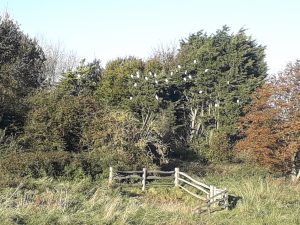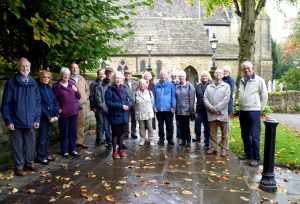Kathryn Stillman kindly sent us a photograph she took of 24 Little Egrets in a tree on the west bank of the Rife opposite the footpath to Clover Lane.
Monthly Archives: October 2017
A Walk around Horsham
On a blustery October morning around 20 members of Ferring Conservation Group met at Horsham Museum for a guided tour to discover some of the hidden secrets of this historic town with our guide for the day, Patricia Hall. This walk followed the trail in the book written and beautifully illustrated by Patricia about Horsham, entitled ‘Armchair Walks in Sussex’.
Patricia began by explaining that the name Horsham comes from ‘Horse Meadow’; a place where horses, cattle and sheep could graze in clearings in the forest.
The impressive Town Hall was our first stop and Patricia captured our imaginations as she described a scene from Elizabethan times when the ground floor was an open arcade and various stalls selling poultry, butter and such like produce was known as the ‘Market House’. The upper floor was where the County Court sat. The ten small ‘holding’ cells in the basement still exist although their windows are now bricked up. The Market House was rebuilt in 1812 by the Duke of Norfolk and his coat of arms can be seen on the front wall.
As we turned into the entrance of Pump Alley, one of several narrow alleyways, we noticed the hinged, wooden letter box on the wall at the site of Horsham’s first Post Office. It was here that letters could be handed directly to the postmaster who sat behind.
We retraced our steps and turned into a pretty road called ‘Causeway’, Patricia pointed out a wall plaque on number 8 Causeway which commemorates the War Hospital Supply Depot. This was established in 1915, during the First World War, to collect materials for hospital use to send to war zones in Europe.
Jane Hayman from the Group said “As we strode along Patricia encouraged us to turn our attention to the skyline and note the many diverse styles of architecture which makes this lovely town so special. We were also made aware of the many houses in the Causeway that employ large slabs of sandstone in their roofs extracted locally and known as Horsham Stone or Slates’.
The Museum is not only a beautiful medieval timber-framed building but also houses many fascinating artefacts. The Blazing Saddles room at the rear displayed a variety of bicycles, an old fire engine and also the unique ‘Pentacycle’, invented by a Horsham business man but unfortunately it was not a success. Crime and Punishment is the theme to another of the exhibitions, displaying keys, handcuffs and truncheons from the County Gaol which was demolished in 1845. As we turned into Morth Gardens we noticed the pretty cottages and then turned right into Denne Road and pass Drill Hall and the Lychgate to Denne Road Cemetery on our way to St Mary’s Church. The tall church spire is 156 feet high (nearly 48 metres) and has over 50,000 shingles (wooden tiles) as these are lighter than traditional tiles.
Once again we retraced our steps and headed along the Causeway back to the Museum and completed our walk at our starting point. As we thanked Patricia for a very enjoyable and informative walk, we all agreed that Horsham is indeed a lovely town with considerable historic interest.
Group Meeting – October 2017
We welcomed David Johnston to open our October Meeting. With an audience of over 70 members and visitors David enchanted us with his fascinating collection of photographs from his delightful book entitled ‘A Sussex Wayfarer’s Nature Notes’. This collection of photographs commenced from 1987 when David and his wife Sue would walk in the Sussex countryside and David would note everything they came across, including old farm buildings and machinery, animals, birds and flowers. This very soon built into an impressive archive of over 6,000 35mm slides and photographs – and these are now in possession of the West Sussex Records Office.
David would always make a point of entering into conversation with country folk he encountered along the way and these chats were recorded and made into a collection of country diaries that added yet another dimension to his observations. Many photographs were taken during 1987 both before and after the great storm of that year with David highlighting the contrast of these ‘before and after’ scenes as evidence of the sheer devastation this storm caused.
Tricia Hall delivered her Nature Notes by informing us that both she and Peter Dale had completed a count of the many trees that were planted along the banks of the Rife in 2011. Out of a total of 1,000 trees it was estimated that almost 50 per cent had survived. Kathryn Stillman had photographed 24 Little Egrets on a tree along the west bank of the Rife and a Kingfisher had been spotted at the southern end. Also in the area, a fairly common but very secretive Water Rail had been seen, a Stone Chat, Snipe, a Grey Wagtail and Ring Plover had been sighted on the ploughed area of the Goring Gap. Tricia commented that few butterflies had been seen in late summer especially the Small Tortoiseshell, although they were abundant in the spring. Unusually the honeysuckle along the Rife was experiencing a second flowering.
Ed Miller brought us up to speed with planning news by advising us that planning permission for a ninth residence at the former Beehive Cottage site had been refused. Also WSCC Highways were soon to take action on the road layout to make it safer for vehicles entering Sea Lane from the southern exit of Sea Lane Gardens.
